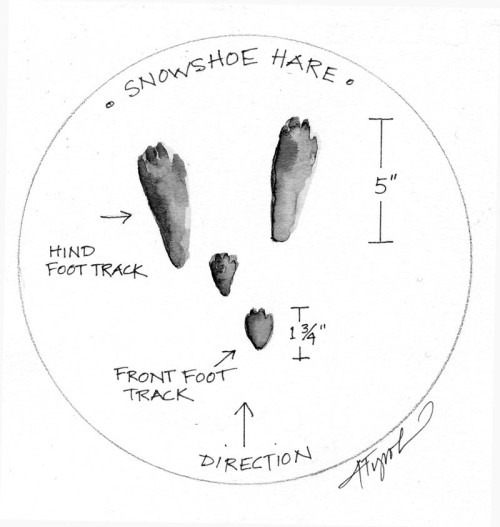
The tracks in the snow were everywhere, penetrating into the deepest parts of the thicket, where only small animals go. Inching across frozen landscape on snowshoes, and ducking eye-level twigs, we broached the brush, forcing our way between crowded alders to peer closely at these footprints. No other animal leaves such a track—splayed toes on two huge feet planted side by side, followed by two smaller feet, one behind the other. This animal is none other than the snowshoe hare, at home in a wetland on Godfrey Road in Thetford, Vt.
Snowshoe hare generally are associated with northern coniferous forests, mountains and the frigid expanses of willow woods bordering the Arctic Ocean. Within these zones, snowshoe hare seek out dense stands of young trees and bushes that typically spring up in boreal summits, clearings made by wildfires or by the natural draining of beaver ponds. Dotted with comfortable homes, Godfrey Road is a far cry from the tundra, yet the wetland on our road with its alder thicket is ideal for the hare. Tree and brush felling by beavers helps the thicket endure by keeping reforestation at bay. Thus, while not normally a Connecticut River Valley species, snowshoe hare have found a home here.
These hares have superbly evolved to survive winter. Also called the ‘varying hare,’ their most obvious adaptation is to turn white in winter, camouflaging them from predators. It’s not the onset of cold weather that stimulates the change in fur color, rather it is the decrease in daylight hours. Hares, and many other mammals, have an organ in the brain known as the pineal gland that responds to light. In fact the pineal gland is the vestigial remains of a third eye and in some primitive animals, such as the Tuatara lizard of New Zealand, this gland still has an eye-like structure. In mammals it has assumed the function of making hormones that fluctuate with the seasons, changing metabolism and coat color. Color change in hares starts at the feet and belly, then spreads to the body in mottled patches; and eventually, over the course of two months, the hare turns completely white. The fact that coat color change is genetically hard-wired is evident from the fact that in cases when the ground remains brown, the hares still turn white and become easy pickings for predators.
Under normal circumstances, hares escape predation through their coloration and by hunkering down under logs or evergreen cover, where they remain still for much of the day. At dusk they venture out, traveling well-established routes to feeding areas. The hares construct these routes under cover of conifers or in brush that is difficult for predators to see into, and they keep the lanes clear by nipping off twigs that grow in their path. Travel over snow is made easy by their large, heavily furred rear feet. These ‘snowshoes’ prevent them from sinking into the snow and enable them to outrun predators.
Another winter adaptation, one that is not evident to the eye, is the ability to exist on a poor diet. The hare’s summer browse, soft herbaceous plants and berries, lies dormant under snow in winter. What remains might seem unfit to eat—woody stems, conifer needles and tree bark protruding above the snow. Hares manage to glean nutrition from this unpromising material thanks to special bacteria that live in a special intestinal sac, the cecum. The hare’s digestive tract sorts food into highly fibrous material that passes quickly through the gut, and more nutritious material that is shunted into the cecum. Bacteria in the sac do the hard work of breaking down otherwise indigestible substances such as cellulose.
Hares also extract as much nutrition as possible from their food by recycling their fecal pellets. They eat the pellets so they can be digested for a second time. This behavior, repugnant to us, is called coprophagy, and it is common to all hares and rabbits. In addition, unlike its other long-eared relatives, the snowshoe hare will readily eat carrion to boost its protein intake.
Despite their survival tools, snowshoe hares fall prey to various carnivores, most commonly foxes, lynx, coyotes, mink, great horned owls and goshawks. Indeed, mingled with the hare tracks in the Godfrey Road wetland, we found footprints of weasels, foxes and coyotes, reminding us that snowshoe hares are only one element in the food web of this Vermont wetland far from the northern tundra

